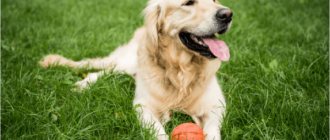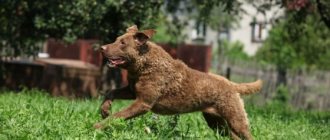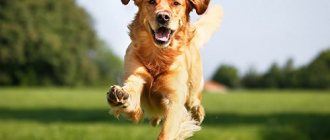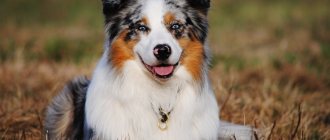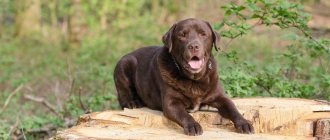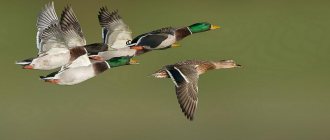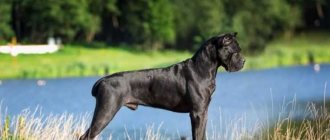Tollers are devoted to only one person, the leader of the pack. But they are also loyal to other family members. Another distinguishing feature is intelligence. Among the disadvantages are impatience of loneliness, exposure to stress, and severe shedding.
Brief characteristics of the Nova Scotia Retriever breed
- Other possible dog names: Toller, Nova Scotia Duck Tolling Retriever.
- Adult dog height: 45-51 cm.
- Weight: 17-23 kg.
- Characteristic color: various shades of orange, possible white markings.
- Coat length: medium.
- Life expectancy: up to 15 years.
- Advantages of the breed: a good hunter with a cheerful character.
- Difficulties of the breed: dogs quickly get bored with the monotony, and they begin to mischief; Scottish Retrievers are hyperactive.
- Average price: 800 – 700 dollars.
Description of the breed with photos
All retrievers are hunting dogs . The ability to find and bring prey to the owner unharmed is important.
To do this, they need to have a hunting sense of smell and a sensitive soft mouth. By nature, these are smart dogs that can be trained.
Size and weight
Among all the varieties bred, these are the smallest retrievers. The weight of males does not exceed 23 kg , females - ranges from 17-20 kg.
The body is compact, yet muscular, which indicates endurance. The physique needs to be maintained by training, so constant walks and games are required.
The stance of this breed is easily distinguishable. She is graceful, her head held high, her neck level with her spine.
The size of males and females differs slightly. For the former, this is a height of 48-51 cm, for the latter - 45-48 cm. These sizes allow everyone to keep them at home comfortably, but they need constant physical activity.
Color and coat type
In order for tollers to perform their hunting function in any conditions, the requirement for the properties of wool was taken into account during the breeding process. It is elastic and has a water-repellent undercoat, since duck hunting involves possible immersion in water. The hair is straight, waviness is allowed on the ears and tail. After shedding, the fur may curl on the chest and thighs.
This is a long-haired breed , with the exception of the muzzle, where the hair is short but densely growing. The ears are also covered with short and pleasant to the touch hair. The tail looks like a feather and is completely feathered by the age of 1.5 years.
The color of the warm shade varies from soft beige to reddish . The monotony is diluted with white hair on the chest, at the end of the paws, tail or muzzle.
History of the origin of the Nova Scotia Retriever
The Nova Scotia Retriever, also called the Toller, was first mentioned in written sources in the 17th century. Around this time, dogs of this breed were brought from Europe to the American continent, including Canada.
The history of the appearance of tollers in Europe is not known. But there is a version that they originate from the Danish Kooikerhondje, since it is dogs of this breed that are similar to Scottish retrievers not only in appearance, but also in the way they lure game. Shelties, collies, cocker spaniels, and Irish setters participated in the creation of the breed. The breed did not develop in Europe; all selection for improving Tollers was carried out in America.
The breed was named the Little River Duck Dog . In 1945, she was recognized by the Canadian Kennel Club. After the war, duck retrievers were brought to Europe. Currently, these dogs are widespread in England and the Scandinavian countries. There are few such dogs in Russia. They are known mainly only among a narrow circle of waterfowl hunting enthusiasts.
But now in Russia there are several nurseries for breeding Nova Scotia retrievers.
Content Features
The Nova Scotia Retriever can live in a yard, in an aviary, in a house or in an apartment. It easily adapts to various conditions, if one requirement is met - the dog will not be deprived of attention and will receive the necessary physical and mental stress, will walk and work a lot.
Tollers shed profusely. On walks they like to roll around in the mud or swim in a puddle if there is no body of water nearby. The breed is not the best choice for purists or allergy sufferers.
It is very important to constantly challenge the toller, both physically and mentally. This is the key to happy coexistence between dog and owner. But at the same time, it is a disadvantage for people who are not active enough; they will not be happy with an intelligent and energetic Scottish Retriever.
Care
Toller care includes regular brushing of the coat and bathing as needed. Pet dogs are usually given a full bath with shampoo and conditioner every 1.5 to 2 months. Street 2-3 times a year. It is important to prevent the formation of tangles and regularly examine the ears and skin. The auricle is cleaned as needed. Claws, if they do not have time to grind down, are trimmed to the optimal length approximately once every 3-4 weeks.
Exhibition grooming includes: washing, drying, combing. Light trimming of the fur on the paws, behind the ears, chest, tail and paws is allowed. It gives the appearance a more neat appearance, but should not be excessive. The Nova Scotia Retriever is shown looking as natural as possible.
Nutrition
The Nova Scotia Retriever is generally not a picky eater. Allergy sufferers are rare among dogs of this breed. In addition, they are not prone to overeating. If they lead an active lifestyle, they remain in good shape until old age. The owner can provide a complete diet using natural products or ready-made dry food. A small retriever is suitable for diets suitable for medium-sized dog breeds that lead a normal or active lifestyle. In the cold season, as well as during periods of active physical activity, it is recommended to increase the portion by 1-1.5 times, if necessary.
The purpose and character of the Nova Scotia Retriever
Dogs of this breed are excellent hunters . Their hunting instinct is very developed. Without hunting, the retriever becomes lethargic. But Tollers are also wonderful companion dogs. In this case, to maintain tone, the dog is occupied with play, which to some extent replaces hunting. These dogs are ideal for lovers of dog sports - frisbee and agility.
Despite their small size, retrievers are excellent guards ; they not only begin to bark loudly, but also try to block the way for an uninvited guest.
Tollers always choose one master , the leader of the pack, and obey only him. They do not show aggression towards other animals or people. These dogs get along well with children and willingly take part in their games. They are smart and very quickly acquire the necessary hygiene skills. The dog understands commands well. She is very active, constantly on the move, loves to run and swim .
Tollers require a lot of attention, but can keep themselves busy. These dogs cannot stand the feeling of hunger ; if they are not fed on time, they can begin to chew furniture and things.
Nutrition
These dogs do not suffer from any types of allergies, and therefore there is no need to invent a special menu. Everything is standard: the basis of the diet is proteins (meat, fish), complex carbohydrates (porridge), vegetables and fruits.
The Nova Scotia Retriever is a good hunter and swimmer.
From time to time you can pamper your dog with bones, but you shouldn’t get carried away with them. Bones are well suited as teething aids for the appearance of teeth in Nova Scotia Retriever puppies .
If we are talking about factory feed, then premium food is recommended. Its advantage is that nothing additional needs to be prepared, and vitamins and minerals are already included in the composition. In addition, the dosage is prescribed on the package based on the weight and age of the breed.
It is important not to overfeed your dog because he is prone to obesity. It is worth excluding fatty foods, especially pork, whose fat is simply not digested by the dog’s gastrointestinal tract. You can’t give smoked or salty foods, or pamper your dog with baked goods and baked goods.
Chocolate is strictly prohibited. But a bowl of drinking water, on the contrary, is in great demand. It should be in the dog’s constant access at any time of the day or night.
How to choose a Nova Scotia Retriever puppy
When choosing a puppy, you must take into account the breed standards:
- wedge-shaped skull;
- the nose converges to the tip;
- strong jaws, close-fitting lips, scissor bite;
- the eyes are widely spaced, the eyelids are the same color as the lips;
- the ears are triangular, medium in size;
- the neck is solid, strong and muscular;
- paws are muscular, with well-developed knee joints, hind legs are widely spaced,
- the shoulder blades are adjacent to the back;
- the back is completely straight and short;
- the tail is movable and wide, tapering towards the end.
The toller moves smoothly, the paws move only in a straight line, and in no case should they deviate to the side.
The puppy cannot have a too short tail, the coat should be even and smooth, and the paws should be thick. When visiting a breeder, you should definitely look at the conditions in which the dogs live and what the mother of your future puppy looks like.
Health and life expectancy
The Nova Scotia Retriever is a strong, healthy dog, strong, resilient, easily adaptable, rarely suffers from allergies or digestive problems, and easily adapts to different climatic conditions and lifestyles. However, there are hereditary diseases in the breed, which are important for current and potential owners to know about.
In Canada, they take the issue of toler health very seriously. A list of diseases recommended for screening in all animals and mandatory for testing in breeding animals has been compiled. This will allow you to create a complete database and wisely select breeding pairs. The list of hereditary diseases of the Nova Scotia Retriever includes:
- Hip dysplasia;
- Progressive retinal atrophy;
- Problems with the thyroid gland;
- Diseases of the heart and blood vessels, including congenital defects;
- Malformations that include malocclusions, cleft palate, cleft lip, cryptorchidism, etc.;
- Degenerative myelopathy;
- Degenerative encephalopathy;
- Intervertebral disc disease;
- Liver shunt;
Life expectancy is usually 12-13 years. Retrievers need standard veterinary preventive measures (vaccination, treatment for external and internal parasites, annual medical examination).
Nicknames for Nova Scotia Retriever
Toller is a hunting dog, and this should be taken into account when choosing a nickname. It should be loud so that it can be heard from afar.
a male dog based on his appearance: Red, Brown, Gold, Zloty. By character: Nimble, Buran, Robbery, Ataman, Gladai, Hawk, Flyer. It is also possible to take into account the origin: Seann, Dublin, Pere, Cent.
for bitches : Gerda, Blizzard, Cold, Purga, Vira, Storm, Lady, Ladna, Chara, Oreira.
Keeping and caring for a Nova Scotia Retriever
The main difficulty in caring for a retriever is the need to constantly brush it. During the molting period, this must be done at least twice a day. The dog can be washed only as needed and it is better not to use shampoos; if the coat is very dirty, then you should use soap without strong fragrances.
The dog must have a permanent place in the house. It is better if there are no foreign odors in the room where the dog lives. Retrievers prefer to live indoors , although in the warm season they feel comfortable outside.
What to feed your Nova Scotia Retriever
The puppy should receive a balanced diet . Half of the daily diet may consist of boiled meat. Sea fish and cottage cheese are given once a week. A quarter of the diet is cereals, it is better if it is rice and buckwheat. The rest is vegetables. For a puppy, vegetables should be grated and seasoned with a spoon of vegetable oil. Puppies and adult dogs benefit from fermented milk products.
The diet of an adult dog is almost the same, but you can add boiled offal and gradually introduce raw meat.
Training and education of the Nova Scotia Retriever
Retrievers are quite trainable , but you need to be patient when working with them. The dog may be stubborn and refuse to follow familiar commands. But it is easy to switch the retriever to play. The main thing in working with dogs of this breed is to bring training as close as possible to play.
Like any dog, the Toller is first taught the necessary hygienic skills and habits needed in everyday life. Then simple commands are mastered to help organize safe walks. This is necessary because tollers may begin to chase imaginary game and lose vigilance and orientation on a city street. After this, more complex commands are practiced, and, if necessary, hunting skills begin to be practiced.
Key points in training
Breeders say that Toller, during breeding work, lost some of his mental abilities, so the breed cannot be called the most intelligent. But the owners insist that these are prejudices.
Yes, these dogs are more difficult to train. But this is due to restlessness and stubbornness, and not due to lack of intelligence. Therefore, with a properly developed technique, you can get brilliant results.
The most important rule for this breed is variety.
To conduct a long-term training, you will have to choose a lot of interesting exercises in a playful way that will keep the dog’s attention. Training should be active and fun, the owner should show not only firmness, but also interest
As with other breeds, the use of brute force, raising the voice, and insults is prohibited. If the pet is wrong, the method of correcting behavior is deprivation of toys or treats; severity of voice; feigned resentment.
To raise an obedient, smart pet, you need to start training at 2 months, then the pet is given basic knowledge: daily routine, house rules, feeding schedule, nickname, first commands (“no”, “place”, “near”).
Pros and cons of the Nova Scotia Retriever breed
Advantages. Retrievers are smart and quick-witted. They are devoted to their owner and are ready to protect him. They are excellent hunters. These dogs have a two-layer coat, allowing him to stay in cold water for a long time. They can be kept both in a city apartment and outside the city.
Flaws:
- does not tolerate long periods of loneliness, begins to behave noisily and unpredictably, trying to attract attention; susceptible to stress;
- it is impossible to walk without a leash, they easily get carried away in the pursuit of everything that they take for prey;
- long walks with great physical activity are required; They shed a lot.
Owner reviews of the Nova Scotia Retriever
Linda:
They gave me a Nova Scotia Retriever. I've never been crazy about dogs. But my boyfriend decided that this would be a good gift. I didn't know anything about this breed. For me it was just a little cutie. Nyashka turned out to be smart, she understood every word I said, and we became just friends. Lucy understands every word. All I need to do is repeat the command several times and, if possible, show how Lucy grasps everything. And sometimes he does what he needs to do without studying. But I don’t leave her alone, she starts barking and jumping on the wall. But I found a way out. My neighbor, a pensioner, is happy to keep it with her while I’m at work. Then I read an article on the Internet and was surprised to learn that my Lucy can also hunt ducks!
Nikolay Anatolyevich:
I bought a dog for hunting. I have several dogs of different hunting breeds. The Nova Scotia Retriever is the best option for bird hunting. It is easy to train, does not freeze in the water, and swims like a dolphin. Doesn't react to other dogs. The puppy is not cheap, but it is worth it.
Dear owners of the Nova Scotia Retriever, do you think it is possible to have dogs with such hunting instincts as the Toller as a companion dog? Share your experience with us!
Share
Leave a review
Character
The Nova Scotia Retriever has a unique ability to attract ducks, an ability that he extends to humans. The dog is very cheerful and playful, she is very bored in the apartment, she never runs out of energy.
These dogs are not considered an intelligent breed, so training will take a lot of time and patience. Toller puppies are overly playful and often spoil things in the house, so they need to be trained from the moment they arrive in the house.
This dog is very noisy, even training cannot always stop it from barking for no reason. Tollers cannot stand loneliness; it causes them deep melancholy. These dogs become wonderful companions for small children; the dog will never touch the baby, even if he pulls the dog by the ears.
Despite the excess energy, the dog is not hyperactive , it is athletic and agile, loves to run, swim and is always ready to follow any command.
Duck retrievers are excellent guard dogs and will raise the alarm at any suspicious noise. Dogs have a very strong hunting instinct and will pursue an animal that interests them for a long time. They get along well with pets, especially if they grow up together from early childhood. However, it is better not to get a Toller if there is already a dominant dog in the house - it will be very difficult for them to find a common language.
